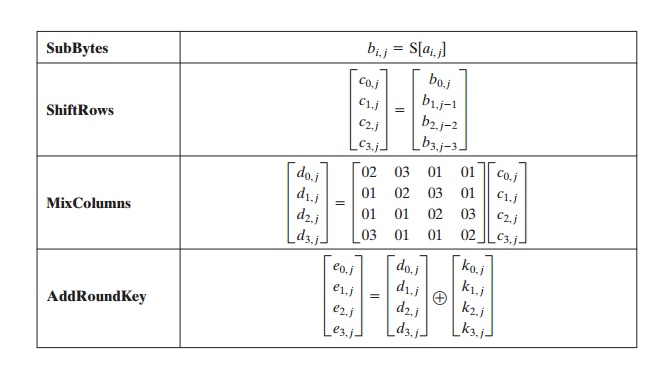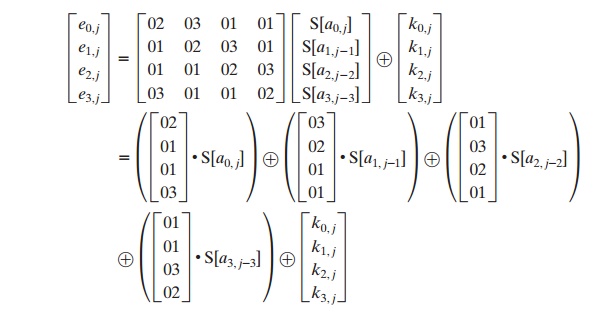Chapter: Cryptography and Network Security Principles and Practice : One Symmetric Ciphers : Advanced Encryption Standard
AES(Advanced Encryption Standard) Implementation
AES
IMPLEMENTATION
Equivalent Inverse Cipher
As was mentioned, the AES decryption cipher
is not identical to the encryption cipher (Figure 5.3). That is, the sequence of transformations for
decryption differs from that for encryption, although
the form of the key schedules for encryption and decryption
is the same. This has the disadvantage
that two separate software or firmware modules are needed for
applications that require both encryption and
decryption. There is, however,
an equivalent version of the decryption algorithm that has the same structure as the encryption algorithm. The equivalent version
has the same sequence of transformations as the encryption algorithm
(with transfor- mations replaced by their inverses). To achieve this equivalence, a change in key schedule is needed.
Two separate changes are needed to bring the decryption
structure in line with the encryption structure. As illustrated in Figure 5.3, an encryption round has the structure
SubBytes, ShiftRows, MixColumns,
AddRoundKey. The standard decryption round has the structure InvShiftRows, InvSubBytes,
AddRoundKey, InvMixColumns. Thus, the first two stages of the decryption
round need to be interchanged, and the second two
stages of the decryption round need to be interchanged.
INTERCHANGING INVSHIFTROWS AND INVSUBBYTES
InvShiftRows affects the
sequence of bytes in State but does not alter byte contents and
does not depend on byte contents
to perform its transformation. InvSubBytes affects the contents of bytes in State but does not alter byte sequence
and does not depend on byte sequence to perform its transformation. Thus, these two
operations commute and can be interchanged. For a given State Si,
InvShiftRows
[InvSubBytes (Si)] = InvSubBytes
[InvShiftRows (Si)]
INTERCHANGING ADDROUNDKEY
AND INVMIXCOLUMNS The transformations Add- RoundKey and InvMixColumns do not
alter the sequence of bytes in State.
If we view the key as a sequence of words, then both AddRoundKey and InvMixColumns
operate on State one
column at a time. These two operations are linear with respect
to the column input. That
is, for a given State Si and a given round
key wj,
InvMixColumns (Si Ⓧ wj) = [InvMixColumns (Si)] Ⓧ [InvMixColumns (wj)]
To
see this, suppose that
the first column
of State Si is the sequence is the sequence (y0, y1, y2, y3) and the first
column of the round key wj is (k0, k1, k2, k3). Then we need to
show

This equation is valid by inspection.Thus, we can interchange AddRoundKey and InvMixColumns,
provided that we first apply InvMixColumns to the round key. Note that we do not need to apply InvMixColumns to the round key for the input to the first
AddRoundKey transformation (preceding the first round) nor to the last AddRoundKey transformation (in round 10).This
is because these two AddRoundKey transformations are not interchanged with InvMixColumns to produce the
equivalent decryption algorithm.
Figure 5.10 illustrates the equivalent
decryption algorithm.
Implementation Aspects
The Rijndael proposal [DAEM99] provides some
suggestions for efficient imple- mentation on 8-bit processors, typical
for current smart cards, and on 32-bit proces-
sors, typical for PCs.
8-BIT PROCESSOR AES can be implemented very efficiently on an 8-bit
processor. AddRoundKey
is a bytewise XOR operation. ShiftRows is a
simple byte-shifting operation. SubBytes operates
at the byte level and only requires
a table of 256 bytes. The transformation MixColumns requires matrix multiplication in the field GF(28), which means that all operations are carried out on bytes.
The transformation MixColumns requires matrix multiplication in the field GF(28), which means that all operations are carried out on bytes. MixColumns only requires multiplication by {02} and {03}, which, as we have seen, involved simple shifts, conditional XORs, and XORs. This can be implemented in a more efficient way that eliminates the shifts and conditional XORs. Equation set (5.4) shows the equations for the MixColumns transformation on a single column. Using the identity {03} x = ({02} x) Ⓧ x, we can rewrite Equation set (5.4) as follows.

The multiplication by {02} involves
a shift and a conditional XOR. Such an imple- mentation may be vulnerable
to a timing attack of the sort described
in Section 3.4. To counter this attack and to increase
processing efficiency at the cost of some storage, the multiplication can be replaced
by a table lookup. Define
the 256-byte table
X2, such that X2[i] = {02} i. Then
Equation set (5.9)
can be rewritten as


32-BIT PROCESSOR The
implementation described in the
preceding subsection uses only 8-bit operations. For a 32-bit processor, a more efficient
implementation can be achieved if operations are defined on 32-bit words. To show this, we first define the four transformations of a round in
algebraic form. Suppose we begin with a State
matrix consisting of elements ai, j and a round-key matrix consisting of elements ki, j.
Then the transformations can be expressed as follows.

In the ShiftRows equation, the column
indices are taken mod 4. We can com-
bine all of these expressions into a single equation:

In the second
equation, we are expressing the matrix multiplication as a linear
com- bination of vectors.
We define four 256-word
(1024-byte) tables as follows.

Thus, each table takes as input a byte value and produces
a column vector (a 32-bit word) that is a function of the
S-box entry for that byte value. These tables can be calculated in advance.
We can define a round function operating on a column in the following fashion.

As a result,
an implementation based on the preceding equation
requires only four table
lookups and four XORs per column per round, plus 4 Kbytes
to store the table.
The developers of Rijndael
believe that this compact, efficient implementation was probably one of the most important
factors in the selection of Rijndael for AES.
Related Topics